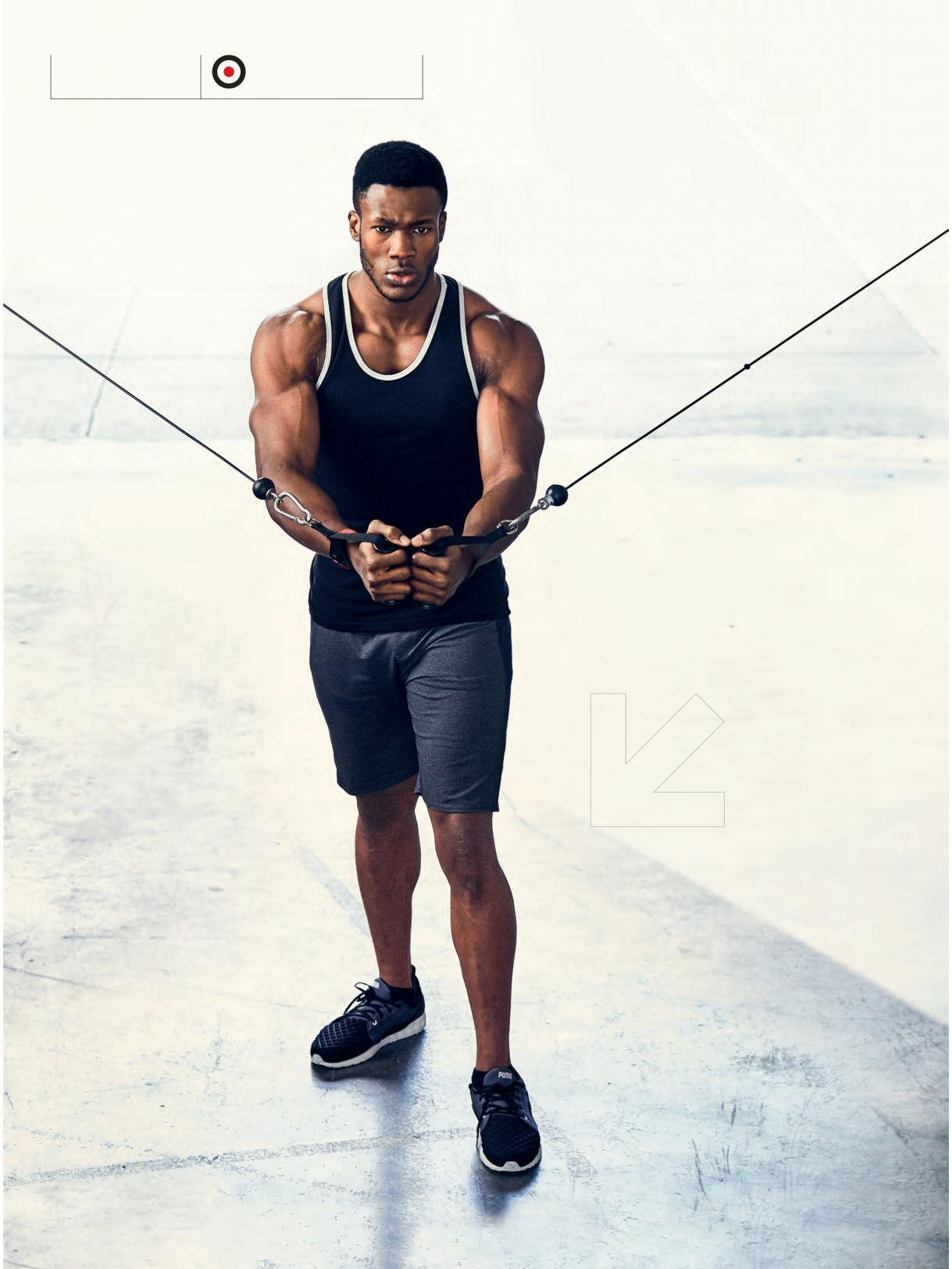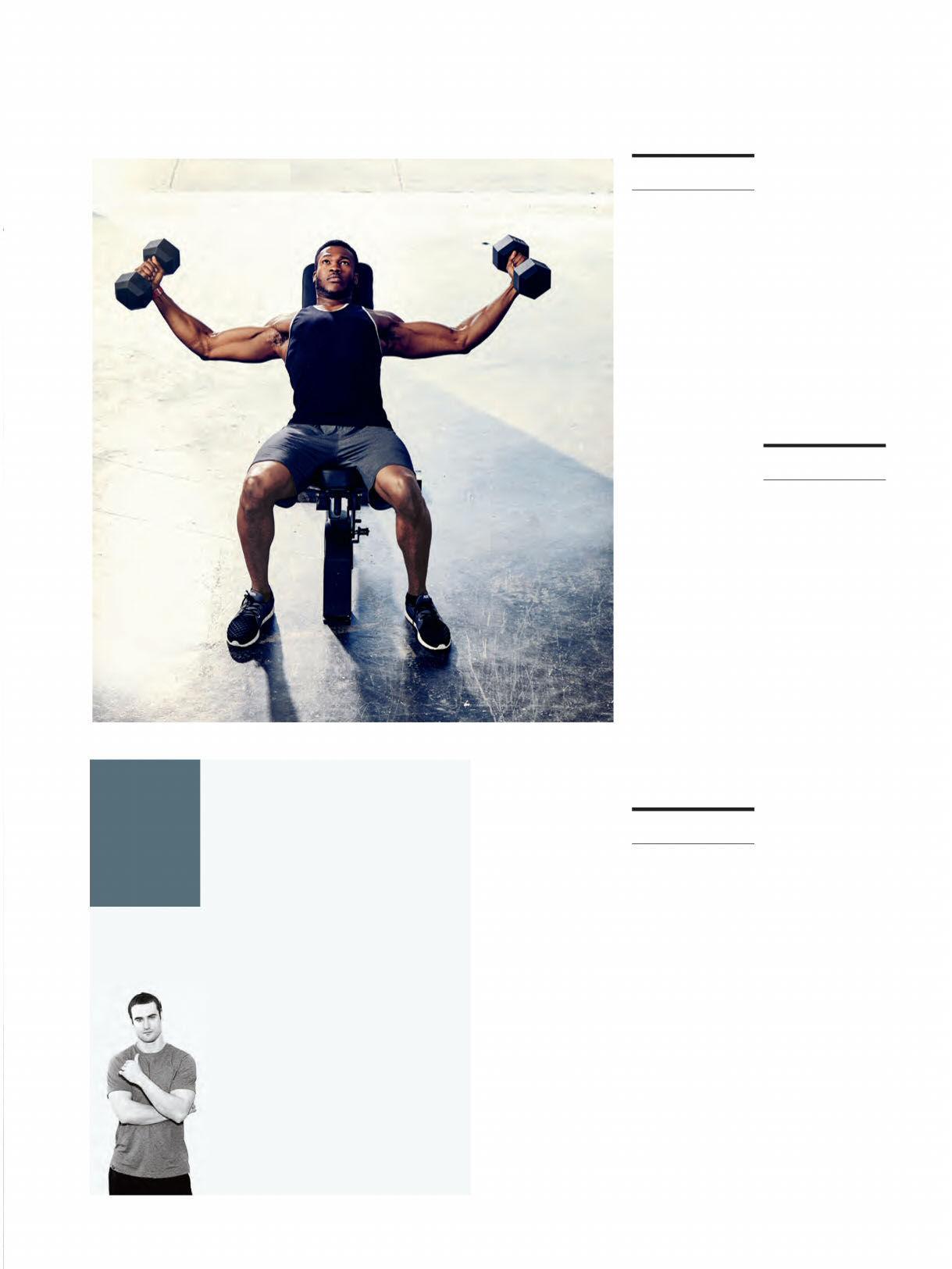
4 minute read
Pecs-tra development
CABLE FLYES DONE SLOWLY EXHAUST THE PEC FIBERS.
Pecs appeal A d d 2 c m t o yo u r c h e s t w i t h t h e s e t ra i n i n g t i p s .
Advertisement
By Sean Hyson Photographs by James Michelfelder
There’s more to chest training than just presses, flyes and cable crossovers done week after week — but that’s the only approach most guys know. Allow us to shed some light on the science of building muscle so you can attack your pecs with a more precise strategy — one that could add up to 2cm of muscle in four weeks.
Balancing act. Lighter exercises like flyes provide contrast to pressing.
HARD FAC T S

O U R T R A I N I N G D I R E C T O R , S E A N H Y S O N , S O LV E S YO U R WO R KO U T C O N U N D R U M S
“What should I eat after a workout to get the best insulin spike?”
■ It’s time to clear up one of the biggest misconceptions about post-workout nutrition. It’s been (correctly) repor ted that your body needs a rise in insulin to drive protein and carbohydrates into the muscles to help them recover and grow. Starchy foods accomplish this, which is why rice and potatoes are staples in any bodybuilder’s diet. But here’s the funny thing: the one time of day you definitely don’t need to boost insulin is immediately after a weight workout.
Research from the Journal Of Applied Physiology has shown that muscle contractions facilitate glucose transpor t into muscle cells, essentially mimicking the work insulin does. In other words, lifting primes the pump for you, so you don’t need a sharp rise in insulin to get nutrition into the muscles.
So, rather than spend money on fancy post-workout supps that spike insulin, eat a piece of whole fruit. Fast-digesting carbs are still impor tant after a workout because they halt muscle breakdown, so a mere banana will get the job done.
Se an Hyson is the Me n’s Fi tne ss trainin g dire c tor and au thor of 101 Be s t Workou ts of A ll Time, 101b e s t wor kou ts.com.
TIP NO. 1 Slow down ■ While the term pumping iron is ubiquitous, it’s a fairly poor description of how properly executed repetitions are performed. Mechanically pumping out your reps allows you to rely on momentum and the stretch reflex to lift the weight, rather than forcing the muscles to work their hardest to do so.
Lower the weights on presses and flyes with a slower cadence and perform the lifting motion with power. A review in The Journal Of Strength And Conditioning Research found that muscle gains were maximised when the lowering phase of a rep takes two to four seconds and the upward phase lasts one to three. Additionally, a 2015 study from Sports Medicine found that muscles grow with rep durations up to eight seconds.
TIP NO. 2 Go heavy, go light ■ It seems that with chest training especially, guys fall into one of two camps. They’re either always loading up the bar to bench-press as heavy as possible, or performing high reps on machine or isolation exercises, denying their muscles the intensity of training heavy. Traning expert Don Saladino says you need to mesh both approaches. “You can develop a bigger chest by lifting heavy weights, which work the type II muscle fibres, and light weights, which hit type I fibres.”
This can be done by training chest twice per week, with a heavy stimulus one day and what Saladino calls a “pump day” four days later. Note that these workouts must be spread out for optimal recovery. On the heavy day do low-rep sets of bench presses, and on the pump day work your machine presses, flyes and other isolation moves.
TIP NO. 3 Deload to reload ■ Nobody can go all-out all the time. When you feel your performance beginning to suf er, or you just need a break from hard training, throw in a deload week. Deloading is a short period of reduced training intensity designed to lower injury risk and promote recovery for better gains to come. It’s not optional. “Deloads give your joints a break from the pounding of heavy weights,” says Saladino. “You also need them when you have adapted to a program and you’re not seeing any more gains.”
There are several ways to implement a deload. You can cut the volume you do in your workouts in half for a week — so if you were doing 20 sets in a session, perform only 10. You can also reduce the loads you lift, using only 60–70% of the weight you used in the previous week’s workouts. Or, Saladino says, simply begin a new program with lighter loads and focus on higher rep ranges. In short, take it easy and come back stronger.










